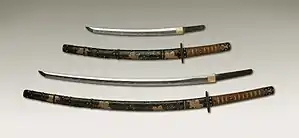Wakizashi
The wakizashi (Japanese: 脇差, "side inserted sword"[1]) is one of the traditionally made Japanese swords (nihontō)[2][3] worn by the samurai in feudal Japan. Its name refers to the practice of wearing it inserted through one's obi or sash at one's side, whereas the larger tachi sword was worn slung from a cord.
| Wakizashi (脇差) | |
|---|---|
.jpg.webp) Blade and mounting for a wakizashi. The blade was made by Soshu Fusamune. Blade, late 15th–early 16th century; mounting, 18th century.There were many different makers for the katana. The Metropolitan Museum of Art | |
| Type | Sword |
| Place of origin | Japan |
| Production history | |
| Produced | Muromachi period (1336–1573) to present |
| Specifications | |
| Blade length | approx. 30–60 cm (12–24 in) |
| Blade type | Curved, single-edged |
| Scabbard/sheath | Lacquered wood |
History and use
The production of swords in Japan is divided into specific time periods:[4]
- Jokotō (ancient swords, until around A.D. 900)
- Kotō (old swords from around 900–1596)
- Shintō (new swords 1596–1780)
- Shinshintō (newer swords 1781–1876)
- Gendaitō (modern or contemporary swords 1876–present)
The wakizashi has a blade between 30 and 60 cm (12 and 24 in) in length.[1] Wakizashi close to the length of a katana are called ō-wakizashi and wakizashi closer to tantō length are called ko-wakizashi.[1] Wakizashi are not necessarily just a smaller version of the katana; they could be forged differently and have a different cross section.[5]
Wakizashi have been in use as far back as the 15th[6] or 16th century.[7] The wakizashi was used as a backup or auxiliary sword;[1] it was also used for close quarters fighting, to behead a defeated opponent[8] and sometimes to commit seppuku.[9] The wakizashi was one of several short swords available for use by samurai including the yoroi tōshi, and the chisa-katana. The term wakizashi did not originally specify swords of any official blade length[10] and was an abbreviation of wakizashi no katana ("sword thrust at one's side"); the term was applied to companion swords of all sizes.[11]
During the Edo period, the Tokugawa shogunate required samurai to wear Katana and shorter swords in pairs. These short swords were wakizashi and tanto, and wakizashi were mainly selected.[12] The wakizashi being worn together with the katana was the official sign that the wearer was a samurai. When worn together the pair of swords were called daishō, which translates literally as "big-little". Only samurai could wear the daishō: it represented their social power and personal honour.[13][14][15] During this period, commoners were allowed to wear one legal-length ko-wakizashi, which made it popular for the general public to wear wakizashi. This was common when traveling because of the risk of encountering bandits.[16][17] Wakizashi were worn on the left side, secured to the waist sash (Uwa-obi or himo).[18][12] It was not until the Edo period in 1638 when the rulers of Japan tried to regulate the types of swords and the social groups which were allowed to wear them that the lengths of katana and wakizashi were officially set.[19]
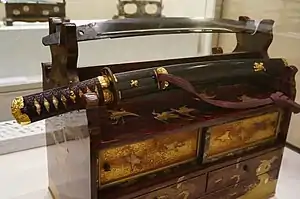
Kanzan Satō, in his book titled The Japanese Sword, notes that there did not seem to be any particular need for the wakizashi and suggests that the wakizashi may have become more popular than the tantō because it was more suited for indoor fighting. He mentions the custom of leaving the katana at the door of a castle or palace when entering while continuing to wear the wakizashi inside.[20]
Gallery
 Wakizashi Ishida Sadamune made by Sadamune. Nanboku-chō period. Important Cultural Property. Tokyo National Museum.
Wakizashi Ishida Sadamune made by Sadamune. Nanboku-chō period. Important Cultural Property. Tokyo National Museum. Wakizashi made by Osafune Motoshige. Nanboku-chō period. Tokyo National Museum.
Wakizashi made by Osafune Motoshige. Nanboku-chō period. Tokyo National Museum. Wakizashi mounting. The metal parts are made by Goto Ichijo. Edo period. Tokyo National Museum.
Wakizashi mounting. The metal parts are made by Goto Ichijo. Edo period. Tokyo National Museum.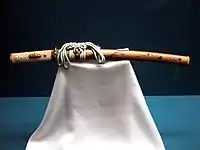 Wakizashi mounting. Edo period. Tokyo National Museum.
Wakizashi mounting. Edo period. Tokyo National Museum.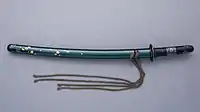 Wakizashi mounting. Edo period. The Metropolitan Museum of Art.
Wakizashi mounting. Edo period. The Metropolitan Museum of Art.
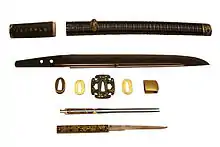 Wakisashi by Sanpin Masatoshi, early 1600s. The disassembled koshirae shows the tsuba (guard), the twin kōgai (hair pin) and the Kozuka (small knife). On display at the British Museum.
Wakisashi by Sanpin Masatoshi, early 1600s. The disassembled koshirae shows the tsuba (guard), the twin kōgai (hair pin) and the Kozuka (small knife). On display at the British Museum.
References
- Ogyû Sorai's Discourse on government (Seidan): an annotated translation, Sorai Ogyū, Otto Harrassowitz Verlag, 1999 p. 105
- The Development of Controversies: From the Early Modern Period to Online Discussion Forums, Volume 91 of Linguistic Insights. Studies in Language and Communication, Author Manouchehr Moshtagh Khorasani, Publisher Peter Lang, 2008, ISBN 978-3-03911-711-6 p. 150
- The Complete Idiot's Guide to World Mythology, Complete Idiot's Guides, Authors Evans Lansing Smith, Nathan Robert Brown, Publisher Penguin, 2008, ISBN 978-1-59257-764-4 p. 144
- Transition of kotō, shintō, shinshintō, and gendaitō. Nagoya Japanese Sword Museum Touken World
- Samurai: The Code of the Warrior, Thomas Louis, Tommy Ito, Sterling Publishing Company, Inc., 2008 P.138
- Samurai: The Weapons and Spirit of the Japanese Warrior, Clive Sinclaire, Globe Pequot, 2004 P.87
- Samurai: The Code of the Warrior, Thomas Louis, Tommy Ito, Sterling Publishing Company, Inc., 2008 P138
- The encyclopedia of nineteenth-century land warfare: an illustrated world view, Byron Farwell, W. W. Norton & Company, 2001 P.240
- A glossary of the construction, decoration and use of arms and armor in all countries and in all times, together with some closely related subjects, George Cameron Stone, Jack Brussel Pub., 1961 P.201
- Handbook to life in medieval and early modern Japan, William E. Deal, Oxford University Press US, 2007 P.158
- Samurai, warfare and the state in early medieval Japan (Google eBook), Karl Friday, Psychology Press, 2004 P.78
- 歴史人 September 2020. pp.42-43. ASIN B08DGRWN98
- The Japanese sword, Kanzan Satō, Kodansha International, 1983 p.68
- Mol, Serge (2003). Classical weaponry of Japan: special weapons and tactics of the martial arts. Kodansha International. pp. 18–24. ISBN 4-7700-2941-1.
- Ratti, Oscar; Westbrook, Adele (1973). Secrets of the samurai: a survey of the martial arts of feudal Japan. Tuttle Publishing. p. 258. ISBN 0-8048-1684-0.
- Taiho-jutsu: law and order in the age of the samurai, Don Cunningham, Tuttle Publishing, 2004 P,23
- The connoisseur's book of Japanese swords, Kōkan Nagayama, Kodansha International, 1998 P.48
- Secrets of the samurai: a survey of the martial arts of feudal Japan, Oscar Ratti, Adele Westbrook, Tuttle Publishing, 1991 P.260
- The connoisseur's book of Japanese swords, Kōkan Nagayama, Kodansha International, 1998 P.35
- The Japanese sword, Kanzan Satō, Kodansha International, 1983 P.68
External links
- Richard Stein's Japanese sword guide
- Wakizashi Japanese Sword Archived 2020-03-02 at the Wayback Machine
